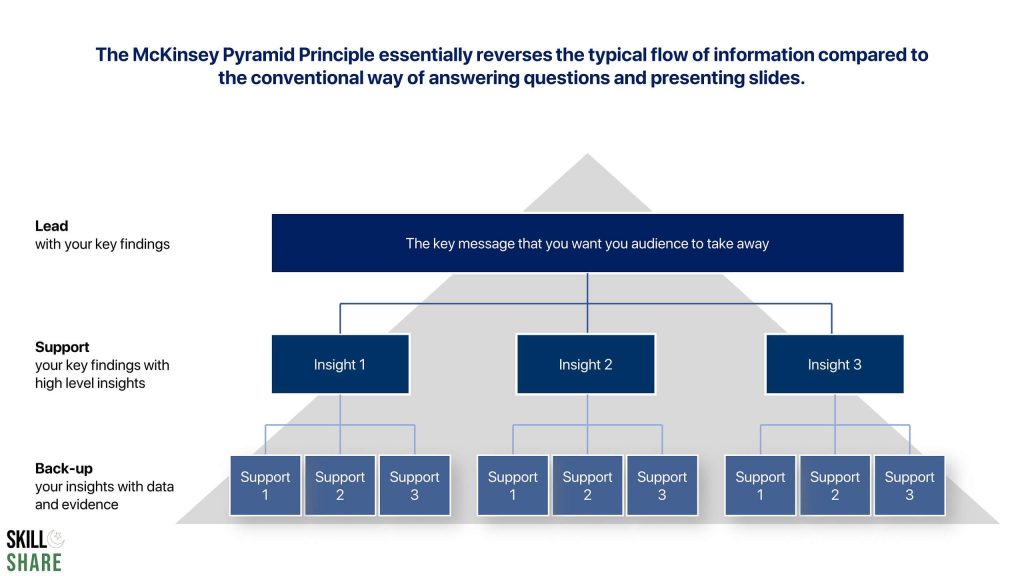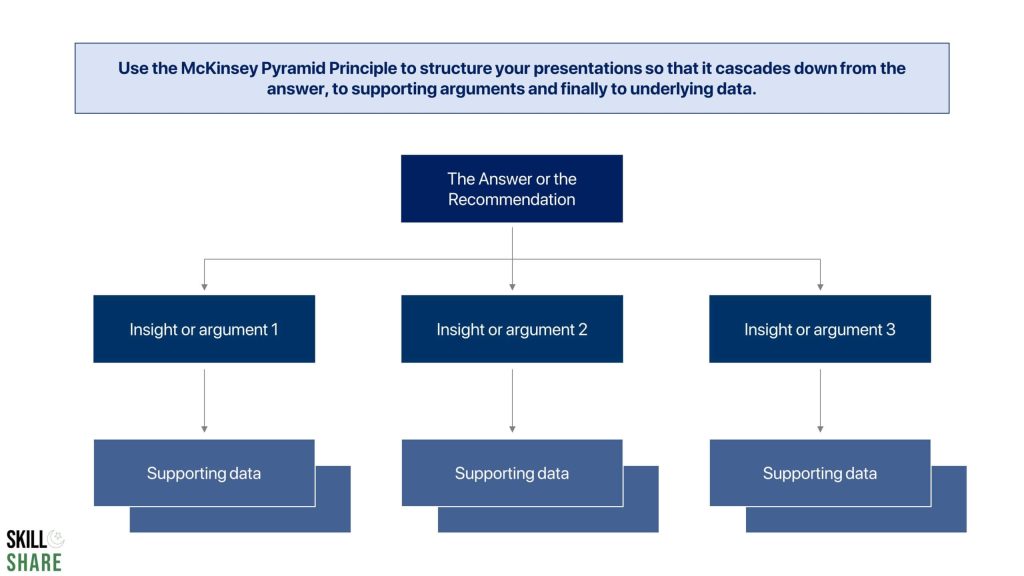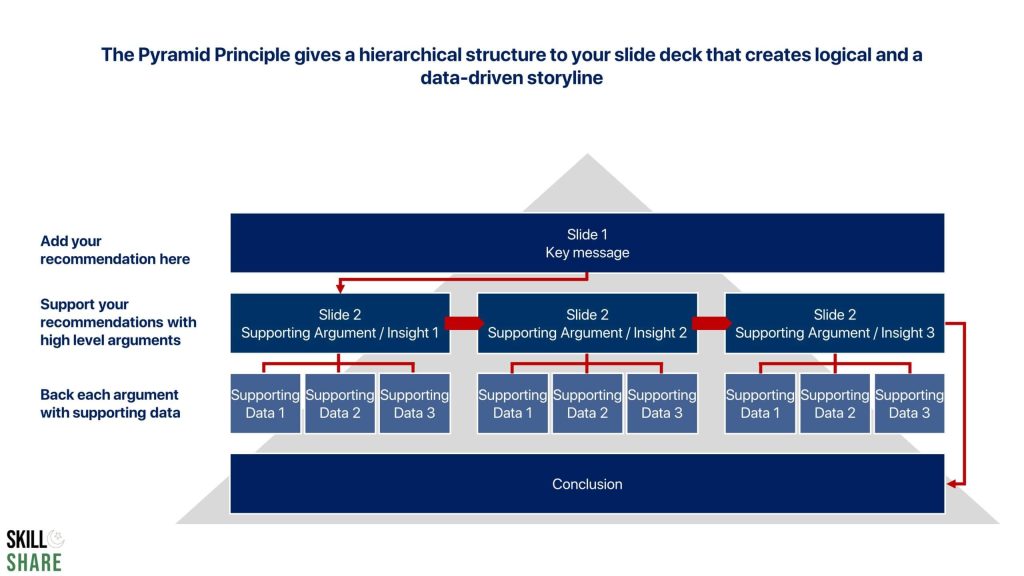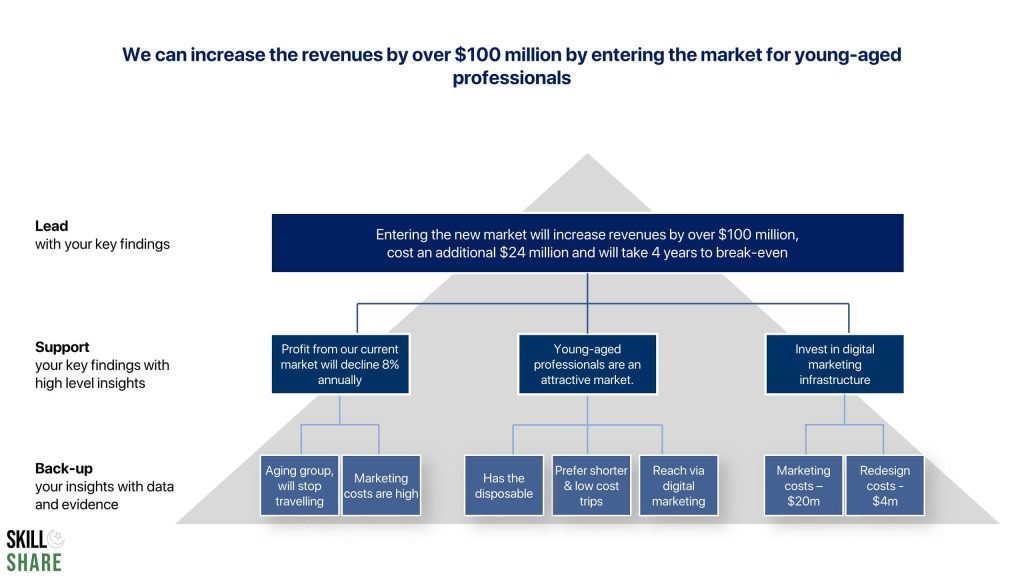Consulting firms put a strong emphasis on the importance of structured thinking and communication. Often, management consultants have to concisely and precisely present recommendations to business executives. In most cases, they have only a few minutes to communicate their recommendations and insights. Then, if the executive was interested in digging deeper and going into details, that was at his or her discretion. As a result, it is crucial that consultants structure their PowerPoint presentations so they can effectively communicate their suggestions.
One of the core tools used by consulting firms to structure their slide deck is the Mckinsey Pyramid Principle, which is exactly what we are going to discuss in this blog.
Why is it important to structure presentations?
Structuring a PowerPoint presentation is extremely important. Management consultants use a structure for various reasons, including:
- Clarity: A clear structure makes it easier for the audience to follow the presentation & understand the main points.
- Engagement: A well-structured presentation keeps the audience engaged and focused on the presentation.
- Persuasion: A structured presentation ensures a logical flow of information and makes the points more compelling.
- Organization: A structured presentation helps the speaker stay on track
- Time management: A well-structured presentation can help the speaker manage their time effectively and ensure that they cover all the necessary information within the allotted time.
- Impact: A well-structured presentation can make a lasting impact on the audience and leave them with a clear understanding of the material.
What is the Mckinsey Pyramid Principle
When creating presentations, consulting firms almost always use the Mckinsey Pyramid Principle, an effective methodology for structured communication. The Mckinsey Pyramid Principle is an effective communication tool that helps quickly and clearly communicate suggestions, ideas, and business recommendations to executives.
The Pyramid Principle was developed by Barbara Minto, a McKinsey consultant, and is used not only at McKinsey but at almost all of the top consulting firms.
The McKinsey Pyramid Principle suggests that you begin with the answer or conclusion. Then present the arguments that led to that conclusion, as well as the data that supports them.
In this article, we will discuss how to use presentation structures using the McKinsey Pyramid Principle.

The conventional presentation structure
This is how most people structure their presentation slide deck:
Slide 1: Problem identification
Slide 2: Data point 1
Slide 3: Data point 2
Slide 4: Data point 3
…
Slide X: recommendation
Structuring your slide deck like this has a few problems:
First, the reader has to keep multiple insights and thoughts in their minds without any context or idea of where the argument is leading. This makes it easier for them to lose their attention and lose track of what is being discussed.
Secondly, when you structure your presentations like this, you are diving straight into the details. Oftentimes, the reader is more concerned about the answers and recommendations than the details. This is particularly true for C-level executives.
This can undermine your efforts and play down the suggestions that you have made in the presentation slide deck.
On the contrary, management consulting firms structure their slick decks using the McKinsey Pyramid Principle.
Structure slides using the Mckinsey Pyramid Principle
The Pyramid Principle gives a hierarchical structure to your slide deck that creates a logical and data-driven storyline. To put it differently, your presentation should start with an introduction that states both the issue as well as your answer or recommendations for that issue. This is essentially your key message.
This key message is supplemented by supporting arguments that create a logical storyline and result in a more impactful presentation. Each supporting argument is data-driven, therefore, making your arguments much stronger.

Here are the core elements of the McKinsey Pyramid Principle:
- Lead with the answer: the most important part of the Pyramid Principle is to make your recommendation(s) right away;
- Support the answer with key facts and insights at a high level: synthesize the main takeaways from your analysis that support your recommendations;
- Back key insights up with detailed data, analysis, and evidence: These slides will include many of the analyses that you perform and the summaries of the evidence that you gather. These will help you and the reader understand the situation clearly and see how it adds up to your recommendations.
The McKinsey Pyramid Principle essentially reverses the typical flow of information compared to the conventional way of answering questions and presenting slides. However, the Pyramid Principle is a valuable communication tool for consulting firms.
This is how McKinsey structures slide decks using the Pyramid Principle
Using the McKinsey Pyramid Principle, you would structure your slide deck like this:
Slide 1: an Executive Summary with key recommendations
Slide 2: Summary of argument 1
Slide 3: Supporting data point 1 for argument 1
Slide 4: Supporting data point 2 for argument 1
Slide 5: Summary of argument 2
Slide 6: Supporting data point 1 for argument 2
Slide 7: Supporting data point 2 for argument 2
Slide 8: Summary of argument 3
Slide 9 Supporting data point 1 for argument 3
Slide 10: Supporting data point 3 for argument 3
…
Slide X: Conclusion / Recommendations / Next Steps
Why Is the Pyramid Principle an Effective Communication Tool?
The McKinsey Pyramid Principle is valuable for structuring and organizing discussions with executives.
Management consultants usually work on complex problems. If the clients’ problems were easy to solve, they would solve them with their own teams. Therefore, management consulting teams perform a lot of analysis and research on every project.
However, the clients don’t usually have a lot of time to absorb all the information and insights. Hence, the Pyramid Principle helps busy executives absorb your message quickly because it leverages the vertical relationships between the key points.
- Top-level: The summary point you need to communicate
- Second level: The key points supporting the top-level point
- Third level: Data that supports second-level points

When using the McKinsey Pyramid Principle, you lead with the answer first, communicating your summary point. This helps the listener absorb your point and understand where the argument is leading. Next, you support your leading argument with insights. This is the second level. Finally, you use third-level data that supports the second-level points and clarifies any questions or ambiguities. This strengthens your argument further.
Each piece of information in your pyramid supports the level above it, according to the Mckinsey Pyramid Principle.
Communicating Using the McKinsey Pyramid Principle Is Especially Important with Executives
The Pyramid Principle is especially important when you’re talking to C-level clients. They have paid thousands of dollars for the consulting project and want to know if it was worth it. Therefore, they want to know that your recommendation will significantly improve their revenues, profitability, or other key metrics that are essential for their business.
For example, a client would simply ask you to start the meeting with a list of cost-saving recommendations and their projected impact for the rest of the year. He may not necessarily be interested in going over any details immediately. Therefore, avoid putting your recommendations and their impact at the end of a long slide deck.
When executed well, the McKinsey Pyramid Principle provides the framework to share the answer first, followed quickly by the most important supporting points, and then followed by key details.
Using the McKinsey Pyramid Principle to Structure Your Analysis
Here’s a case study to demonstrate how to use the Pyramid Principle to structure your presentation and provide recommendations:
Your client is a travel company with a mature client base. They are looking to expand their business and target new customer segments while also catering to their current customers. The client’s current marketing spend is almost entirely focused on emails and banners.
The question we’re trying to answer is:
How should your client think about expanding their service mix and revising their marketing spend to serve the new customer segments and increase revenues by $100 million?
(Let’s assume you’ve successfully done all the research and analysis to support the numbers presented below.) Your argument could look like this:
Top-level (lead):
We can increase revenues by over $100 million by entering this segment, but it will require an investment of $X million and take T years to grow the business.
Second and third levels (support and backup):
- Our client’s current mature customer base drives $250 million in revenues per year. Profits from this group are $40 million and expected to start declining by 8% annually as this group ages and stops travelling. Additionally, marketing costs are significantly higher than peers at 25% of revenue due to the cost of direct mail.
- Priority growth segments include young-aged professionals who are looking for shorter trips and lower-cost options. They can be reached more efficiently through digital marketing. This segment’s low-cost travel preferences are offset by the efficiencies of digital marketing.
- We will need to invest in digital marketing infrastructure to reach a younger customer segment. Our client will also need to adapt their travel offerings to include shorter trips that are more accessible to key target segments.
- Our client can unlock an additional annual opportunity of over $100 million in revenue by aggressively targeting this segment. The cost to revamp the marketing infrastructure would be approximately $20 million while the cost to redesign the customer experience would be $4 million.
Synthesize your findings and structure your slide deck using the McKinsey Pyramid Principle

Conclusion
In this article, we learn how important it is to structure our presentation slide decks to effectively communicate our insights. We discovered how management consultants use the McKinsey Pyramid Principle to structure their PowerPoint slides.
If you want to learn more about how management consultants prepare their presentation slides and the tips that they use, check our comprehensive guide on how to create consulting presentations.